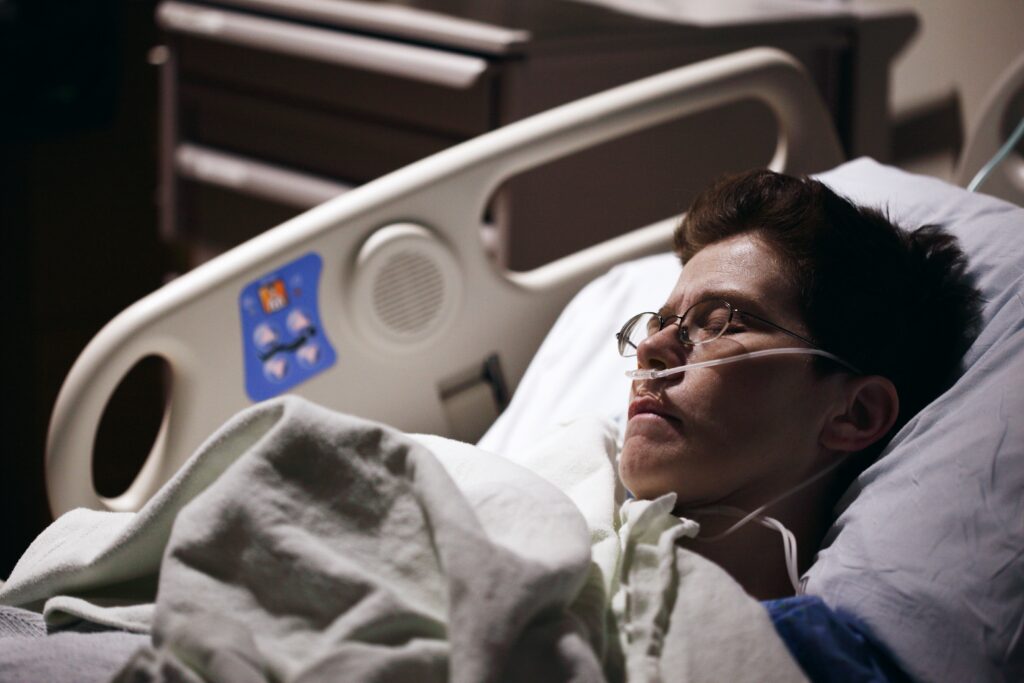More often than you might think, people with eating disorders don’t recognize or acknowledge they have a problem. They may be full-blown into eating disorder behaviors while turning a blind eye to how severely ill they are. . Getting treatment for an eating disorder, therefore, can be difficult. And recognizing when eating disorder inpatient treatment is warranted can be especially so.
The irony?
The sooner a person with an eating disorder is in treatment, the better the prognosis.
That doesn’t mean “just any treatment,” however.
What matters is that the level of specialized care is suited for the severity of the disorder’s symptoms.
The highest level of care available is eating disorder inpatient treatment.
Pursuing eating disorder treatment at any level of care isn’t easy.
Knowing when to pursue eating disorder inpatient treatment is especially difficult, probably because it’s the most extreme form of treatment.
Insurance companies may beg to differ, but the process of discerning the need for inpatient care is not an exact science.
There are, however, some generalities to help you evaluate if and when inpatient treatment is the way to go.
Why is it so difficult to pinpoint the best treatment for an eating disorder?
For one thing, eating disorders thrive in secrecy. Those who have them tend to hide their behaviors from others and are reluctant to disclose them to family, friends, or providers.
They also tend to refuse eating disorder treatment. Because the eating disorder has often become their identity and primary coping mechanism, they’re understandably reluctant to relinquish it.

The statistics about eating disorders aren’t meant to be scare tactics. They’re facts intended to raise your awareness…and your responsiveness.
Only one in three people with anorexia nervosa receives mental health care. For bulimia nervosa, the numbers are much lower – approximately 6%.
Eating disorders affect people of all ages, genders, races, sexual orientations, and socioeconomic levels.
Surprisingly, more middle-aged people are requiring hospitalization than ever before. And more men are being identified, with numbers now thought to be as high as 4 out of 10 people with an eating disorder.
Not everyone with an eating disorder is in need of inpatient care, however.
The primary reason for eating disorder inpatient treatment is medical and psychiatric stabilization.
But inpatient treatment for those who need it is often lifesaving. Literally.
Eating disorders can be fatal.
Eating disorders also have a 100% recoverability potential, especially when the level of care matches the person’s symptoms and circumstances.
What are the levels of care for someone with an eating disorder?
The continuum of care for eating disorders includes:
- outpatient care (psychotherapy, meetings with a registered dietician
- intensive outpatient programs (IOP)
- day treatment or partial hospital programs (PHP)
- residential programs (resi)
- inpatient hospitalization
It’s not uncommon for a person in treatment for an eating disorder to move up and/or down levels of care, depending on how s/he is doing in recovery.
Keep in mind that no two people with an eating disorder are the same. Factors that vary can include symptom severity, motivation, treatment history, co-occurring psychiatric or medical issues, ability to pay, health insurance coverage, and medical stability.
What are considerations for eating disorder inpatient care?

Inpatient level of care is expensive and usually short-term. It provides a very structured environment and 24/7 clinical care.
In many cases, the most important goal of hospitalization is to stabilize acute medical symptoms. This, in essence, is the beginning of normalizing eating and weight.
The majority of eating and weight restoration usually takes place in the outpatient setting.
Psychiatric instability (depression, self-harm behaviors, suicidality)
You may be severely depressed or suicidal or have other comorbid psychiatric illnesses. If so, your best bet is eating disorder treatment in a setting where medical staff can also monitor your mood and adjust your medications as necessary.
Treatment refusal

Sometimes a person with an eating disorder outright refuses treatment. Treatment refusal may lead to tube feeding or other safety measures (e.g. bed restriction).
It’s not uncommon for the brain of someone with an eating disorder to be malnourished and not able to function properly, leading to poor judgment and minimal insight.
Other levels of care have been ineffective
Perhaps you’ve been in outpatient treatment for a long time. Perhaps you’ve even tried partial hospitalization programs.
If your eating disorder symptoms are continuing to worsen, despite the care you’re receiving, you may want to consider inpatient treatment.
Secondary behaviors
Self-harm occurs among at least 25 percent of people with an eating disorder, and perhaps up to 68 percent.
If you have a history of self-harm or feel urges to self-harm, inpatient or residential treatment is a way to be safe.
The same is true with alcohol abuse, over-exercise, or any other behavior that interferes with healing.
Medically compromised (or could become so)
Treatment in an environment that can closely monitor your physical well-being is important. You may need immediate medical attention, and being in a setting where that is available is important.
This is especially critical during refeeding.
The reason?
Particularly for adolescents, prolonged starvation followed by “sudden” eating can cause extreme electrolyte imbalances.
You are not able to gain weight or stop binging/purging at home
A major first step to a full recovery is nutritional restoration. That means no starving, no binging, no purging.
Nutrition restoration may not be something you’re able to do in your current situation. And that’s OK.
Inpatient treatment could help you get started at home, along with the help of a registered dietician with a specialty in eating disorders.
Hospital day treatment programs

Day treatment programs are structured and generally require attendance for multiple hours a day, several days a week. They may include medical care; group, individual and family therapy; structured eating sessions; and nutrition education.
Residential treatment for eating disorders

Residential treatment means you temporarily live at an eating disorder treatment facility.
A residential treatment program may be necessary if you need long-term care for your eating disorder or you’ve been in the hospital a number of times with no improvement in your mental or physical health.
The program may be in a building that is very home-like or in a more hospital-type setting.
Ultimately, the best way to determine if inpatient treatment is required is to be evaluated by an eating disorder specialist.
I have not known anyone with an eating disorder express desire for eating disorder inpatient treatment.
More importantly, however, I have also not known anyone who regrets having had eating disorder inpatient care.
Those who surrender to inpatient treatment come away with enlightenment and gratitude they didn’t anticipate: “It saved my life” and “I didn’t know what I didn’t know.”
Wherever you are on your journey with eating disorder recovery, help is available to meet you exactly where you are.
You got this! And it will be so worth it.
Dr Elayne Daniels is a psychologist and coach in Massachusetts, where she passionately specializes in eating disorder recovery. Please contact her here with any questions.
T
